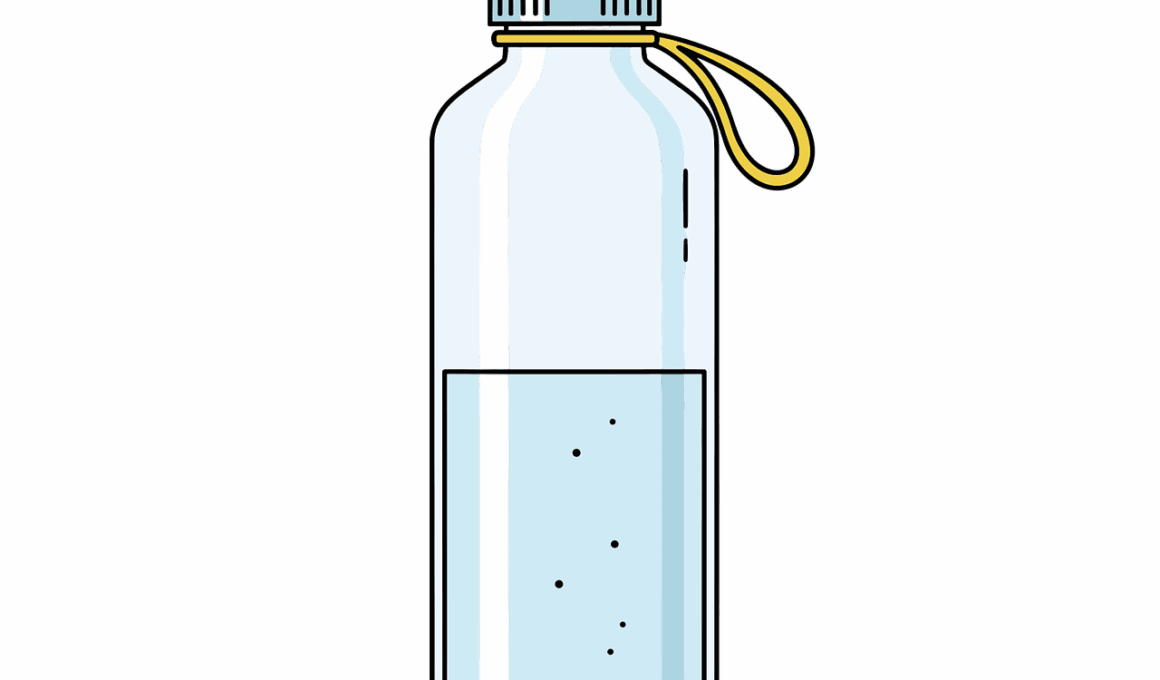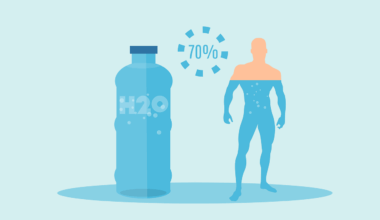Top Hydration Tips for Joint Pain Relief
Maintaining proper hydration is essential for overall health and particularly crucial for joint health. Hydration helps lubricate the joints and maintain their structure. Water acts as a shock absorber for joints, providing cushioning and safeguarding against impact during movement. It also facilitates proper nutrient distribution, helping maintain joint function. Joint pain can be exacerbated by dehydration, making it vital to drink enough fluids daily. To enhance hydration, include a variety of fluids, not just water. You can opt for herbal teas or diluted juices. Additionally, consider consuming water-rich foods such as watermelon, cucumber, or oranges, which contribute to hydration levels. Monitor your body’s hydration status; if you experience dry skin, dark urine, or fatigue, these could be signs of dehydration. It’s particularly important to encourage water intake during exercise or on hot days. Carrying a reusable water bottle can increase your fluid intake throughout the day. Social activities or setting reminders can also help if you forget to drink water regularly. Staying hydrated is key not just for overall health, but also specifically for reducing joint pain and improving mobility.
When focusing on hydration for joint health, understanding your personal needs is vital. Factors such as body weight, activity level, and climate can all influence hydration requirements. In general, a guideline for water intake suggests approximately eight 8-ounce glasses of water a day; however, this may vary. Athletes or individuals engaging in rigorous workouts should increase this amount to compensate for fluid lost through sweat. Using a formula based on body weight can also provide a tailored approach. For instance, some recommend drinking half your body weight in ounces. Temperature plays a significant role; staying hydrated is more critical in hot weather, where sweat loss can be substantial. Monitor your hydration levels by checking urine color; a light yellow shade typically indicates adequate hydration. Listening to your body signals is essential to prevent dehydration. If feeling thirsty, it’s important to drink before becoming too dehydrated, which can lead to various health issues. Drinking water continuously throughout the day, rather than consuming large amounts at once, will help maintain consistent hydration. Overall, understanding hydration based on individual needs can significantly benefit joint health.
Incorporating hydration into your daily routine can be both easy and enjoyable. One effective strategy is to create a schedule or set goals around water intake. For example, aim to consume a glass of water upon waking and with every meal. Use hydration reminders on your phone or apps designed to track daily fluid intake. Consistency is key—establishing a habit will help ensure proper hydration practices. Additionally, flavored water can entice hydration. Infusing water with herbs, fruits, or cucumbers can enhance taste without added calories or sugars. Consider herbal teas for their benefits along with hydration, as many contain anti-inflammatory properties that support joint health. Keeping a water bottle handy throughout the day serves as a visual reminder to drink more. Remember that hydration doesn’t have to come just from water. Foods like soups or smoothies can contribute significantly. The goal should always be to develop a routine that makes hydration enjoyable and sustainable. Regular fluid intake not only aids joint health but also enhances overall well-being and energy levels, contributing to a more active lifestyle and reducing joint discomfort.
Understanding Dehydration’s Effects on Joints
Dehydration can have a profound impact on joint health. When your body lacks adequate fluids, the synovial fluid that lubricates the joints becomes compromised. This lubrication is essential for smooth joint movement. Reduced lubrication can lead to increased friction between joints, resulting in discomfort and an elevated risk of injury. Studies have shown dehydration can intensify the perception of pain. So, ensuring sufficient hydration before, during, and after physical activities is crucial to prevent joint pain. Furthermore, dehydration can hinder the delivery of essential nutrients to joints, impeding repair processes and leading to long-term problems. Chronic dehydration may even promote inflammatory responses in the body, compounding joint issues. Therefore, it’s crucial to recognize the early signs of dehydration. Feeling fatigued, experiencing headaches, or having dry mouth can signify your body needs more fluids. Educating oneself on these signs fosters a proactive approach to hydration. Regular fluid intake can help restore balance within the body, optimize joint function, and reduce discomfort. To manage joint health effectively, prioritize hydration as a fundamental aspect of daily routines and lifestyle choices.
Physical activity plays a vital role in joint health. However, it can lead to increased fluid loss which can exacerbate dehydration if not adequately managed. If you participate in high-intensity workouts or endurance sports, being proactive about hydration becomes crucial. Knowing how much water to drink before, during, and after exercise is important. Experts recommend drinking at least 16-20 ounces of water two hours prior to exercising. During physical activity, aim for approximately 7-10 ounces every 10-20 minutes, depending on the intensity. Post-exercise, rehydrate with another 16-24 ounces to replenish lost fluids. Electrolyte-rich drinks can also guide recovery, especially after intensive workouts. Pay attention to signs of dehydration during workouts, such as dizziness or an unusual drop in energy levels. A well-hydrated body helps with joint pain management by keeping the joints lubricated and minimizing friction. Mixing up hydration methods—such as consuming coconut water for electrolytes—can provide variety and additional benefits. Ultimately, ensuring hydration during and after workouts can lead to improved joint comfort, enhancing performance while reducing pain and stiffness in the long run.
Hydration and Diet Connection
The connection between hydration and diet cannot be overlooked when addressing joint health. Food can significantly impact hydration levels. Certain foods, especially fruits and vegetables, contain high water content, which adds to your daily fluid intake. Watermelon, oranges, and strawberries are excellent options that can also provide vital vitamins for joint health, including vitamins C and E. These vitamins aid in collagen formation, which is essential for joint structure. Consuming a balanced diet enriched with omega-3 fatty acids, found in fish like salmon, can further reduce inflammation, complementing hydration efforts. Including ingredients like chia seeds or flaxseeds in your meals adds both fiber and healthy fats, promoting overall well-being. Additionally, avoiding diuretics such as caffeine and alcohol can improve hydration status. Rather than cutting these out entirely, moderation is key. Combining hydration-focused foods with adequate water intake can have synergistic effects on joint health. Thus, making informed dietary choices that focus on hydration along with a focus on micronutrients enhances overall health and alleviates joint discomfort for a more active lifestyle.
For those dealing with chronic joint issues, exploring additional hydration methods can yield benefits. Adding electrolyte supplements or hydration powders to your hydration routine can help combat imbalances. These supplements aid in rehydration, particularly after exercise or during sleep when fluid loss can occur. Herbal infusions may also be beneficial; many herbs possess anti-inflammatory properties that can enhance joint health. Regularly incorporating ginger or turmeric into your diet, whether in teas or meals, can help reduce inflammation while supporting hydration. Additionally, considering the timing of hydration is essential. Consuming fluids before bed can sometimes lead to disruptions, while drinking upon waking can boost hydration levels. Balancing fluid consumption throughout the day mitigates the risk of discomfort during nighttime. Explore creative ways to stay hydrated; smoothies or blended soups are delicious options that combine hydration and nutrition. Be mindful of salt intake as it can lead to water retention, countering hydration efforts. Staying hydrated and adopting dietary strategies for joint health creates a holistic approach that empowers individuals to manage their joint pain effectively.
Overall, enhancing hydration is an essential aspect of maintaining joint health. By focusing on fluid intake, individuals can alleviate discomfort and promote mobility. Embracing hydration tips helps improve inflammation control, ultimately leading to better joint function. Start with small, manageable changes; gradually increase daily water intake, incorporating hydrating foods into meals for added benefits. Make hydration enjoyable—develop a routine that works for you. Whether you prefer using flavored water or herbal teas, find what keeps you motivated. Adjust hydration strategies based on activity and the environment to remain proactive against dehydration. Remember, the optimal hydration strategy isn’t a one-size-fits-all approach; tailor it to your personal needs. Prioritize hydration as a key factor in achieving better overall health while reducing joint pain. Consider keeping a hydration log to track progress; this encourages consistency. Discuss any hydration and joint health concerns with a healthcare professional to ensure individual needs are properly addressed. Ultimately, enhancing hydration should be viewed as a long-term commitment to well-being. By fostering healthy hydration habits, individuals can pave the way for a more comfortable and active lifestyle.


